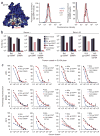Broad HIV-1 neutralization mediated by CD4-binding site antibodies
- PMID: 17721546
- PMCID: PMC2584972
- DOI: 10.1038/nm1624
Broad HIV-1 neutralization mediated by CD4-binding site antibodies
Abstract
We have identified several patient sera showing potent and broad HIV-1 neutralization. Using antibody adsorption and elution from selected gp120 variants, the neutralizing specificities of the two most broadly reactive sera were mapped to the primary receptor CD4-binding region of HIV-1 gp120. Novel antibodies to the CD4-binding site are elicited in some HIV-1-infected individuals, and new approaches to present this conserved region of gp120 to the immune system may result in improved vaccine immunogens.
Figures


References
-
- Haynes BF, Montefiori DC. Expert Rev Vaccines. 2006;5:579–595. - PubMed
-
- Burton DR, et al. Nat Immunol. 2004;5:233–236. - PubMed
-
- Mascola JR, et al. J Infect Dis. 1996;173:340–348. - PubMed
-
- Wyatt R, Sodroski J. Science. 1998;280:1884–1888. - PubMed
-
- Steimer KS, Scandella CJ, Skiles PV, Haigwood NL. Science. 1991;254:105–108. - PubMed
Publication types
MeSH terms
Substances
Grants and funding
LinkOut - more resources
Full Text Sources
Other Literature Sources
Medical
Research Materials

